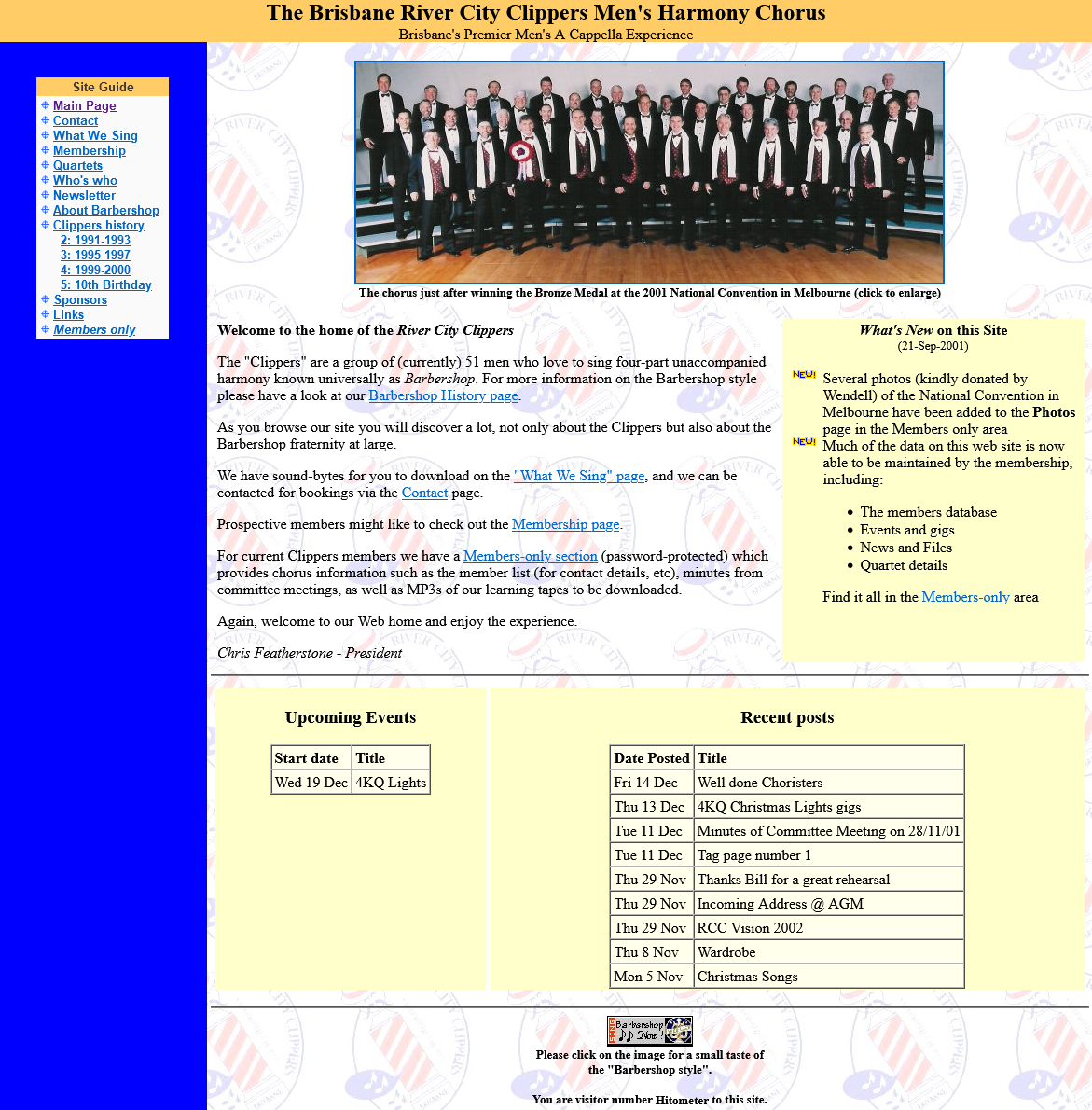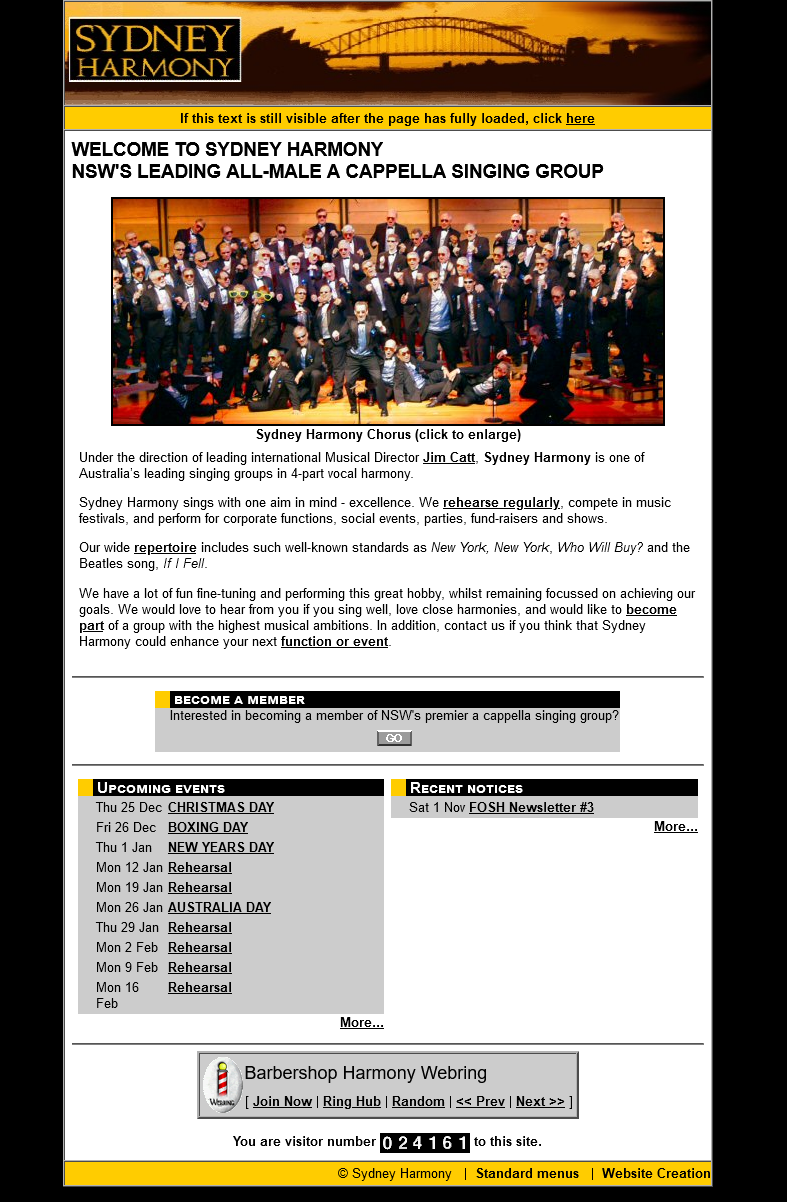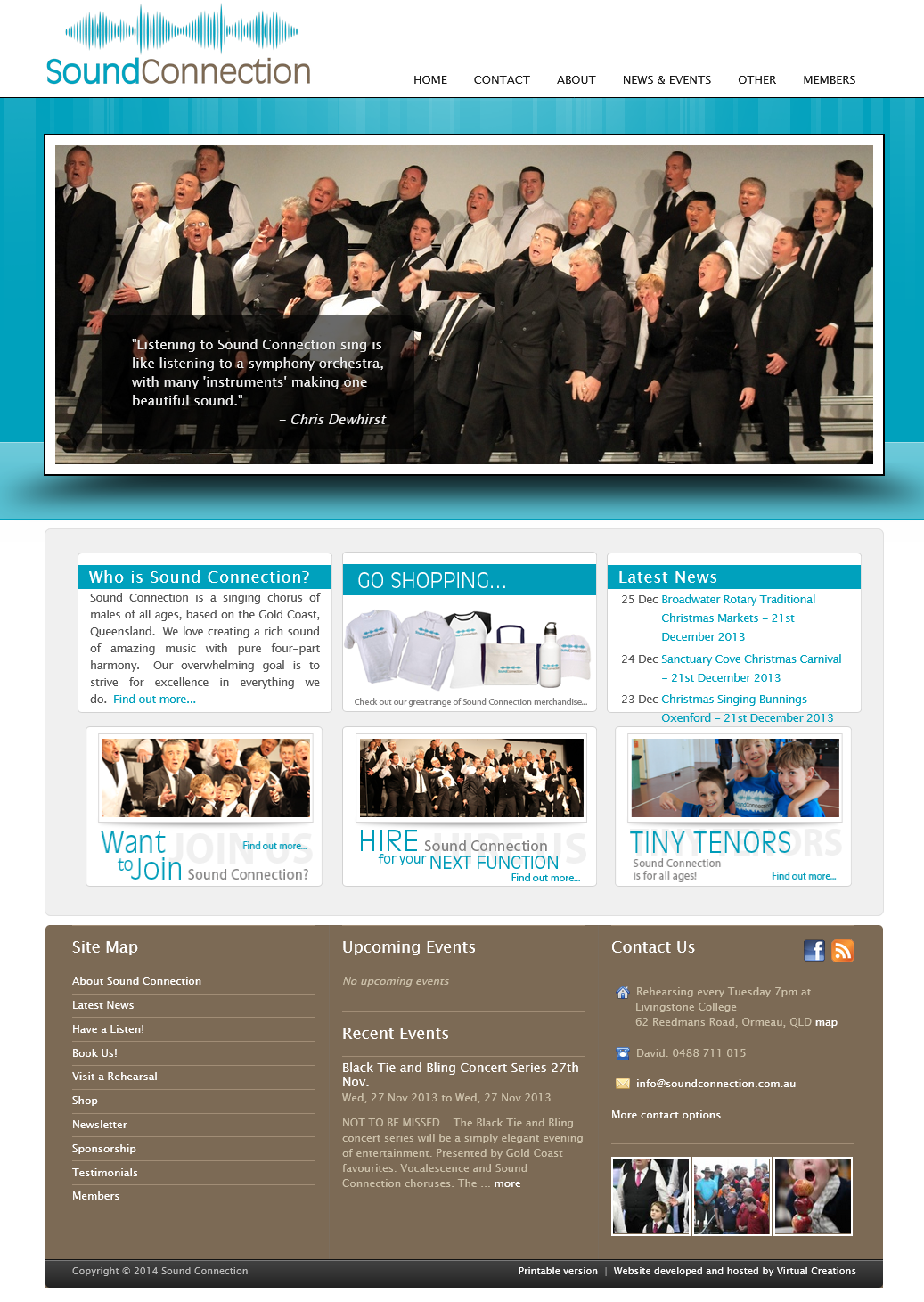The History of HarmonySite
VERSION 1 – 2001
HarmonySite began in July 2001, shortly after Mark Virtue joined his first Barbershop chorus, the Brisbane River City Clippers, in Brisbane, Australia. The “Clippers” had been talking about getting a website developed for the chorus for a few months, but nothing had happened yet. Mark volunteered for the task.
Mark had never built a dynamic, data-driven website before. He had taught himself HTML a few years earlier, and built a few simple websites, but never anything that used a database, where the content of the pages was loaded dynamically from the database. He had no idea even where to start. A fellow singer said to contact a guy called Brett Logan, who had built something similar for The Blenders (a nearby chorus). Mark called Brett, who said the magic words: “PHP” and “MySQL” (the name of a website programming language and database system, respectively). Mark had not used either technology before, but had been a professional programmer for 16 years, so wasn’t afraid to dive in and see what happened.
Mark threw himself into the project, excited by the potential, and worked 15-hour days for two weeks, until he had a rudimentary website and database. He started completely from scratch, not being aware of such things as website “application frameworks” or “content-management systems”, which were just starting to appear, such as WordPress or Drupal.
Here’s what he came up with – the first HarmonySite (although the name “HarmonySite” wouldn’t exist for another 12 years)…

You can browse an archived copy of this website here: https://web.archive.org/web/20011214170015/http://www.rivercityclippers.org.au/welcome.php
The website had the following databases..
- Members
- Songs
- Events
- Posts/documents/news
- Quartets
- Positions
- Links
That’s all – no databases for pages, navigation links, or even logins.
There was a members area, accessible by one single password, shared by all members. There was also an admin area, also accessible with a single password.
VERSION 2 – 2002
A short time later, Mark moved to Sydney, where he joined another Barbershop chorus, Sydney Harmony. They too were in need of a website, and again, Mark volunteered, knowing what to do this time. He went into another coding frenzy, adding many more features, including a database of pages and navigation links, mailing lists, access levels, as well as individual passwords for each member. Admin functionality was incorporated into each page, so you could update a member profile directly from the member profile page (ditto for songs, events, etc). A nicer “theme” was developed, and this was the result…

(The pull-down navigation menu, across the top of the page, somehow didn’t make it into the archive.)
You can browse an archived copy of this website here: https://web.archive.org/web/20031220181921/http://www.sydneyharmony.com.au/dbpage.php?pg=home
Sydney Harmony were so happy with the website that they awarded Mark the Barbershopper of the Year award in 2002.
Over the next 3 years, about 15 more singing groups around the world heard of these websites, and wanted one for themselves.
Then in 2005, Mark left Sydney Harmony, and Barbershop in general, and stopped developing new websites for singing groups. He was building commercial websites professionally now, and felt there was very little money to be made in making websites for singing groups, who were all non-profit organisations with little spare cash. His pricing for singing-group websites was simple: Charge around $500 to build the site, after which the only ongoing cost would be for hosting (around $80 per year). It was time-consuming work to create each new HarmonySite, which the $500 didn’t even begin to cover. So he dropped the whole project. The 17-ish existing sites continued to exist, but no new sites were built.
In the meantime, Mark continued to develop his new business of developing bespoke websites for commercial clients, using the same code platform that he had developed for the singing-group websites. Mark’s company, Virtual Creations, became focussed solely on building and hosting websites.
VERSION 3 – 2012
Seven years later, living in a different part of Australia, Mark was invited to join a brand new Barbershop chorus, Sound Connection. They told Mark they’d be getting a website from Groupanizer, to which Mark responded, “No, don’t do that – I’ll build you a better website, for free!” They agreed.
Another frenzy of work began…
- The website got a modern new look
- Many new features were added
- The name “HarmonySite” was invented
- The code was completely overhauled, so that if a group needed a new HarmonySite, one could be deployed in 15 minutes, instead of around 10 hours
- Every HarmonySite created from then on would share the same codebase, instead of separate source code for every website
- A new server, just for HarmonySites, was commissioned
- A new pricing model was created: Zero set-up fees, and $250 per year, including hosting
This was the result…

You can browse an archived copy of this website here: https://web.archive.org/web/20140114225314/http://www.soundconnection.com.au/
HarmonySite the “product” was born. Mark built a website for HarmonySite (this website – www.harmonysite.com), and started promoting this new product around the world. It was an instant hit.
VERSION 4 – 2014
All the Barbershop choruses that Mark had belonged to were part of Barbershop Harmony Australia (BHA), the “parent body” of all male Barbershop choruses in Australia. They too needed a new website, but their needs were a little different. Their member database comprised of every Barbershopper in Australia, spread over all the choruses. Many of these choruses were now using HarmonySite, each with their own member database, so it seemed wrong to have a completely separate member database containing all the same members. Mark decided that a novel approach was required: The BHA website would share a database with all the choruses/websites. This had never been done before, anywhere in the world. It introduced a whole new level of complexity to the HarmonySite code and database structure, but there was no real alternative.
So Mark rewrote the code again, and separated out the following into a single common database, shared between all HarmonySites…
• Members (and participations, and memberships)
• Events (and venues)
• News
• Ensembles (choruses, quartets, etc)
• Clubs/chapters
• Websites (all HarmonySites in the world were added to a database, containing all their configuration details)
• And a few more, like committees, positions, conventions, etc
Once that was released, then whenever a member’s details were updated in a chorus’s website, the change was instantly visible in the “parent” website (and vice versa). Ditto for all chorus/chapter details, events, news, etc.
MAKING MUSIC – 2019
HarmonySite continued to grow steadily, both in customers and in features. Support staff were hired, to cope with the increasing workload.
In 2018, Mark was contacted by Making Music, an umbrella organisation for amateur music performance groups in the UK, with nearly 4000 member groups. They wanted to offer their member groups a useful and robust way of managing their group (members, music, events, etc). They reached out to Mark, and an arrangement was reached. Making Music would become a HarmonySite reseller. Their version of HarmonySite was identical, but rebranded as the “Making Music Platform”. Mark flew from Australia to London in 2019, to train up their staff in how to deploy and support HarmonySites.
Then, with their own server, separate from the HarmonySite server, they commenced rolling out HarmonySites (sorry, Making Music Platforms) to their member groups. As at 2024, 38% of all HarmonySites are Making Music Platforms.
THE APP – 2023
In 2023, Mark was approached by Chris Shepherd (also from the UK, from Cottontown Chorus, a UK-champion chorus that was using HarmonySite) asking if he could develop an app for HarmonySite. Getting an app developed had been a goal of Mark’s for several years, but it was very hard to find the right person to do it. There had already been two failed attempts, using other developers. Mark told Chris what the app would need to be able to do, and Chris said he could do it. He was right! In 2023, the HarmonySite App was released, and was an instant success. Within 12 months, 50% of groups that had a HarmonySite had purchased the App.

Today
What started as a sort of a side-hustle, HarmonySite has become the tail that wagged the dog. Mark’s company, Virtual Creations, is still building and hosting commercial websites (nothing to do with HarmonySite or performance groups), but the HarmonySite product has grown to provide more than 80% of the company revenue.